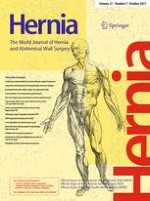Erschienen in:

22.07.2017 | Original Article
Umbilical hernia repair in pregnant patients: review of the American College of Surgeons National Surgical Quality Improvement Program
verfasst von:
I. N. Haskins, M. J. Rosen, A. S. Prabhu, R. L. Amdur, S. Rosenblatt, F. Brody, D. M. Krpata
Erschienen in:
Hernia
|
Ausgabe 5/2017
Einloggen, um Zugang zu erhalten
Abstract
Background
Umbilical hernias present commonly during pregnancy secondary to increased intra-abdominal pressure. As a result, umbilical hernia incarceration or strangulation may affect pregnant females. The purpose of this study is to detail the operative management and 30-day outcomes of umbilical hernias in pregnant patients using the American College of Surgeons National Surgical Quality Improvement Program (ACS-NSQIP).
Methods
All female patients undergoing umbilical hernia repair during pregnancy were identified within the ACS-NSQIP. Preoperative patient variables, intraoperative variables, and 30-day patient morbidity and mortality outcomes were investigated using a variety of statistical tests.
Results
A total of 126 pregnant patients underwent umbilical hernia repair from 2005 to 2014; 73 (58%) had incarceration or strangulation at the time of surgical intervention. The majority of patients (95%) underwent open umbilical hernia repair. Superficial surgical site infection was the most common morbidity in patients undergoing open umbilical hernia repair.
Conclusions
Based on review of the ACS-NSQIP database, the incidence of umbilical hernia repair during pregnancy is very low; however, the majority of patients required repair for incarceration of strangulation. When symptoms develop, these hernias can be repaired with minimal 30-day morbidity to the mother. Additional studies are needed to determine the long-term recurrence rate of umbilical hernia repairs performed in pregnant patients and the effects of surgical intervention and approach on the fetus.